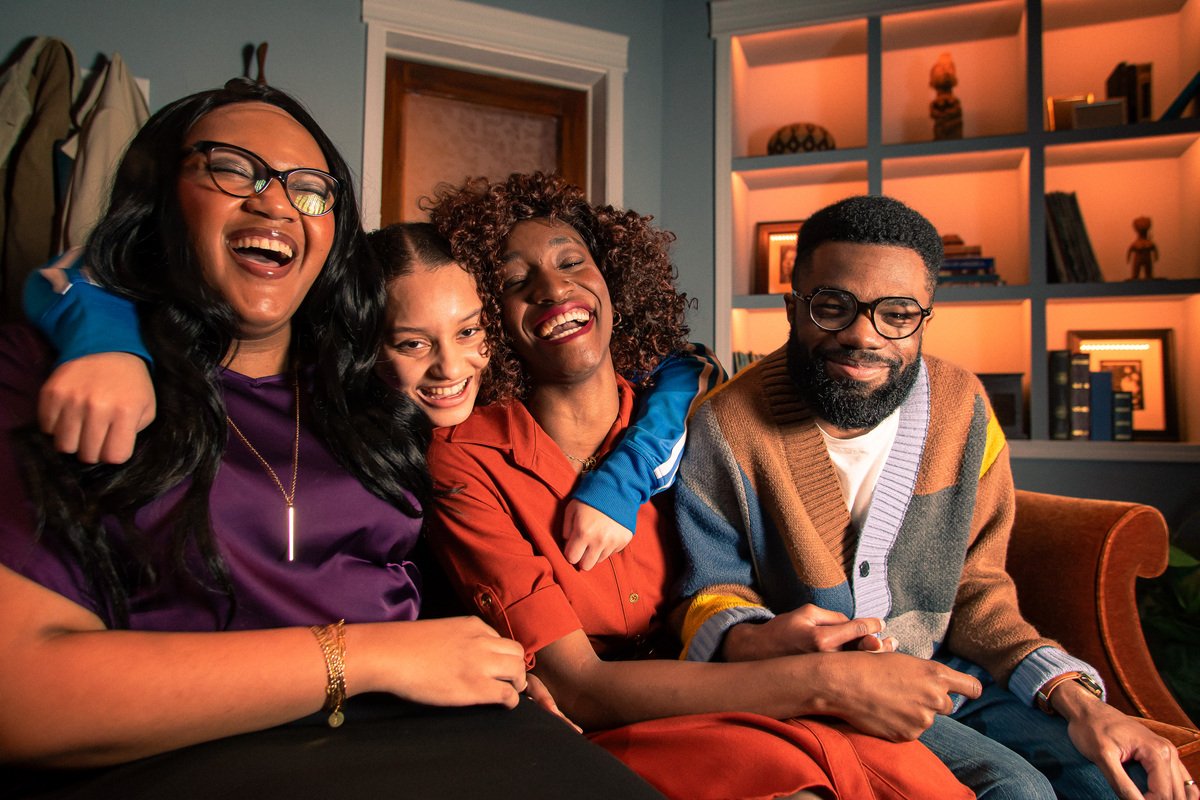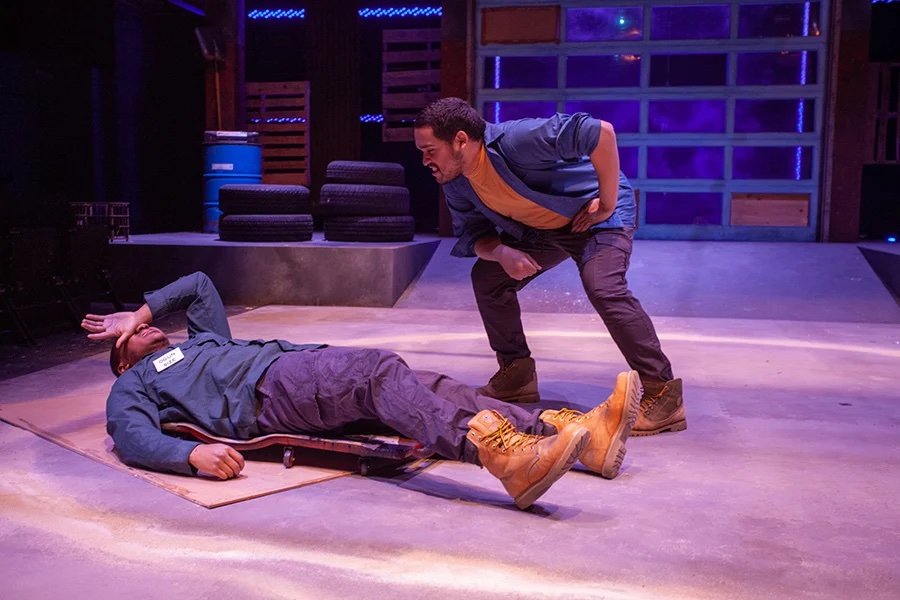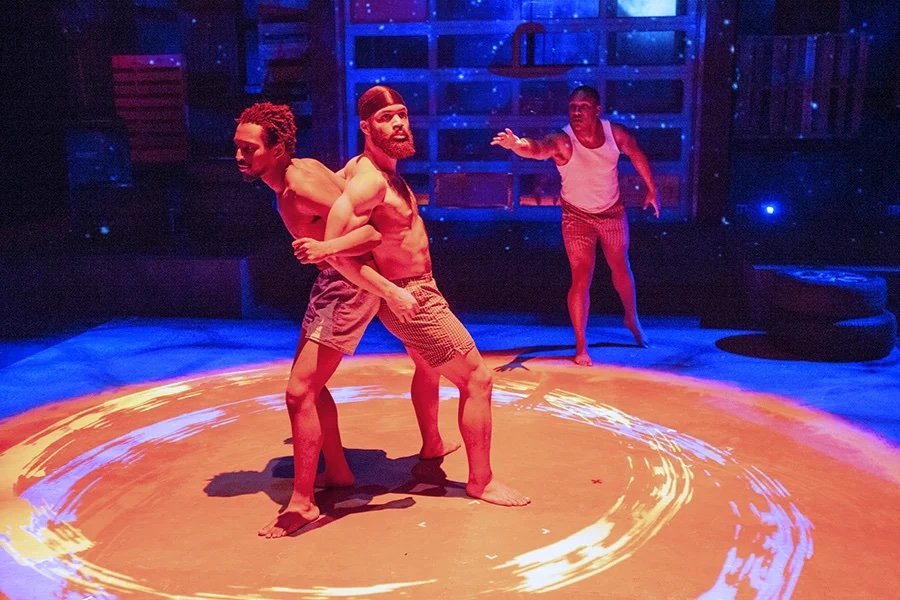Arts & Culture
By Vivian Ewing
Photos by: Lukas Keapproth
April 9, 2024
An antique dining table, an upholstered ottoman, and a blanket draped over an armchair with calculated effortlessness. It might look like your great aunt’s house, but it’s the set of Fairview, a Pulitzer prize-winning play by Jackie Sibblies Drury. DeRon Williams, PhD, is directing the show at Loyola this spring.
This set is designed to feel familiar and welcoming. That’s also the objective of the show—to draw audiences in to observe what at first feels like an easy, charming comedy about a Black family preparing for grandma’s birthday dinner. Hijinks and antics ensue and the audience laughs along, until the sitcom-style storyline starts to glitch and crack.
First, white voices and then white bodies intrude. Then, in the third act, the reality of the play crumbles along with the fourth wall as Keisha, the family’s daughter, played by Trinity Bryant, delivers a searing final monologue.
At the beginning of a recent rehearsal, Williams sat with Bryant at the dining table on stage.
“Who is Keisha?” he asked her.
“Well, she’s confident,” Bryant said.
As other cast members filtered into the theater that evening, Williams and Bryant, along with assistant director Avery Thompson, continued to talk about her character. Then they broke down that important last monologue phrase by phrase, word by word.
Williams has been conscientious and intentional with his cast from the beginning. The themes of the play—racism, surveillance—are sensitive and nuanced, and the idea of acting out the more difficult moments provoked nerves among some actors.
“I knew that we had to facilitate a brave space,” Williams says, “a space where people felt brave enough to let down their guard, to be open for dialogue, and to allow these characters to come into their body.”
Scenes from opening night for the Fairview production in the Bob Newhart Theatre on February 15, 2024. (Photo: Lukas Keapproth)
This kind of work is what Williams cares about. Whether he’s on the stage or in the classroom, he’s a mission-focused educator at heart, and he has been from the beginning.
“When I was little, I used to line up my bears and teach them,” he says. Williams grew up in Pensacola, Florida, and Augusta, Georgia.
His interest in theater grew in college, along with some important questions that have since informed his work and scholarship. “I went to a predominantly Black high school, and then I attended a historically Black university, Albany State University, in southwest Georgia,” he says.
He later received a master’s degree in arts administration from Eastern Michigan University and a PhD in fine arts with a specialization in theater and performance from Texas Tech University.
But it was back at Albany State where he began to interrogate how theater was taught.
“One thing I quickly learned was that a lot of theater history really centered around Eurocentric ideas and inventions and playwrights and artists. And it struck a curiosity in me as to why HBCUs don’t have more graduate programs to facilitate the research of Black culture and performance centered around theater.”
A guiding question emerged: “How can I contribute to this body of work?”
Williams has since co-edited an anthology of writing titled Contemporary Black Theatre & Performance: Acts of Rebellion, Activism, and Solidarity, published in 2023.
“As a scholar, as a person, I’m interested and invested in theater and performance that reflects the contributions of African American artists and scholars and just great thinkers.”
This ethos led him to Fairview, which he has taught in two of his classes and is bringing to the stage for the first time.
“I would love for this play to serve as the launching pad for community change and community conversation.”
— DeRon Williams , Assistant professor of theatre and Institute for Racial Justice affiliate faculty member
Fairview is part of a movement of theater that centers the Black experience in overt ways. The play, Williams says, is in conversation with other works, such as What to Send Up When It Goes Down by Aleshea Harris. “At the very top of that show,” he says, actors address the audience: “It’s ‘Hey, welcome to the show,’” he says, paraphrasing the opening. “‘I’m sorry, white people, but this isn’t necessarily for you. Please stay in the space, but know you might feel some disconnection. It’s our space to commune together, find joy, find mourning, and catharsis.’”
As audiences will see, Fairview flips parts of that dynamic on its head while still providing a catharsis for Black viewers.
To help the cast become comfortable with the issues that provoke such joy and mourning in Fairview, Williams brought in Justin Wright, an anti-oppressive pedagogies specialist at Loyola, and Cristin Carole, an instructor of theater at Loyola who works with intimacy on stage. Both led workshops that helped the students comfortably approach the material and each other.
Judi Nwonye, who plays Beverly, Keisha’s mother, says that Williams himself has also been instrumental in creating this feeling of welcome.
“He opens the floor for anyone to talk—Black, white, whatever—to share their own experiences,” she says. “He shares his own experiences with race, and we can piggyback on that with experiences of race or gender and sexuality.”
Dramaturge intern Kate Wexler felt similarly. She described how white actors are asked to mimic certain racist stereotypes during the play.
“There’s going to be discomfort in that,” she says. “He helped create the safe space to be uncomfortable, to portray these characters in the way they’re meant to be portrayed, to pay homage to the characters, with the themes it tackles. It’s not easy, creating a safe space.”
And this work has paid off, Nwonye says. “All of us are coming together to create a gorgeous and intimate show where we’re talking about hard topics and still able to laugh at the end of the day.”
There’s comedy and tragedy in Fairview, and both elements help bring us to the goal of the play, or any play, as Williams sees it.
“On the most fundamental level, I want audiences walking away thinking about their position in this world,” he says. More specifically, he says, “I would love for this play to serve as the launching pad for community change and community conversation,” where people are “able to learn about each other’s background and where they come from and understand that these differences are beautiful.”
Scenes from opening night for the Fairview production in the Bob Newhart Theatre on February 15, 2024. (Photo: Lukas Keapproth)
As for the cast, he is seeing many changes already. At the beginning of the rehearsal process, Trinity Bryant, who is playing Keisha, used to “do whatever needs to be done and leave right after,” Williams says. She was “very shy, very reserved.” But Bryant, a dance major, has started to open up on stage and elsewhere, he says.
At a department-wide meeting, Bryant’s dance professor approached Williams. “She said ‘Thank you so much, because I can see a big difference in Trinity,’” he recalls her saying. “‘Since being a part of this play, she has opened up. She has blossomed a lot more.’”
Bryant knows that Keisha is confident. Throughout rehearsal, that confidence came alive. During a scene in Act 1, Bryant was center stage. She delivered a smartly timed monologue about the pressures of adolescence and then bounded off stage with a dancer’s lightness.
With Fairview, Williams aims to provoke this kind of growth in his cast and beyond.
“Our hope is to change the entire world,” he says. “Let me start with those around me.”
February 21, 2024 | 10:15 am CST | By Audrey Hogan
“Fairview” is a poignant and correctly targeted mediation on the violence of the white gaze on Black Americans.
In the final monologue of Jackie Sibblies Drury’s “Fairview,” the character Keisha, played by first-year Trinity Bryant, calls all of the white members up on stage, to see what it feels like to be watched, for once.
To be watched specifically in the way that Black people are incessantly watched, monitored and observed under the racist microscope of the white gaze.
Directed by Dr. DeRon S. Williams, a professor of theater at Loyola, “Fairview” follows the Frasier family consisting of Beverly, played by fourth-year Judi Nwonye, Dayton, played by third-year Justin Turner, Jasmine, played by fourth-year Courtney Lewis, and Keisha as they prepare for Mama Frasier’s birthday dinner.
Their celebration, fraught with stress and the unraveling of the typical sitcom family presented in an opening scene, is interrupted by a troupe of white characters who have been watching the show proceed from the rafters, intent on adopting what they believe to be the Black experience and mimicking it.
Jackie Sibblies Drury was awarded a Pulitzer Prize for drama in 2019 for her writing of “Fairview.” (Courtesy of Joe Mazza)
These characters spend the whole second act looming over both the stage and the audience, creating the illusion that all are being watched. The Fraiser family is silent on stage, miming the exact dialogue of the first act, with the four literally speaking over them.
This is Bryant’s first brush with acting in a play, according to the program — though her impassioned performance would suggest otherwise. In her role as Keisha, Bryant’s command of the stage, alongside thoughtful line delivery, present the certainty and confidence of a seasoned actor.
Nwonye delivers another standout performance in the role of Beverly. “Fairview” marks her return to the stage following a hiatus, according to the program, and shows no signs of rust. Nwonye is effervescent on stage, perfectly encapsulating the sitcom normalcy the opening act depicts and that normalcy’s eventual destruction under the white gaze.
During Act II of the show, the main cast of Beverly, Dayton, Jasmine and Keisha mimed the entirety of Act I while another set of four actors were speaking from the rafters of Newhart Family Theatre. (Courtesy of Joe Mazza)
Phoebe Ludwig, who shined in “Life is Cabaret” earlier this academic year, continues to shimmer — albeit violently — as Suze.
The four white characters represent the four major ways in which white people engage in day-to-day racism. Suze is the liberal white savior. Mack is a gay man who believes he has an inner Black woman. Jimbo believes rap encompasses the entirety of the Black male experience. The European Bets believes Americans care too much about race without being able to recognize the extremely prevalent racism in their own country.
In the final act, these characters make their onstage appearance, acting out the vicious stereotypes they have towards Black people. Their performances demonstrate a punching intentionality — they’re brash and abrasive in their racist depiction of these stereotypes, as the play intends.
This is not — as some members of the audience seemed to interpret it — a moment played for laughs. The chorus of laughter that rang out while this overt minstrelsy was playing out on stage was shocking, almost frightening.
The play is a staunch call for white audience members to consider their participation in the perpetual harms of the white gaze. The rampant appropriation of the Black experience and Black culture by white people should be central to this conversation, as exemplified by the play’s final act.
Featured image courtesy of Joe Mazza
BAC Work: Combatting Systemic Racism Through Artistry and Storytelling
Association for Theatre in Higher Education | Advocacy Committee
Published on March 05, 2020
A heartfelt tale of two brothers navigating the murky waters of race and freedom is being performed at Eastern Connecticut State University through March 8. “The Brothers Size,” written by Academy Award-winning writer Tarell McCraney and directed by Eastern Theatre Professor DeRon Williams, is an African cosmology-inspired story of brotherhood set in the Louisiana bayou.
Ogun Size is a hardworking mechanic who is tenuously reunited with his younger brother Oshoosi after being released from prison. The brothers clash over work ethic and life decisions, as Ogun scolds and attempts to steer his younger brother in the right direction. Matters are complicated when Oshoosi’s alluring former cellmate, Elegba, arrives at the auto shop, sending them down a collision course that probes sexuality, coming of age and the bonds of family.
Director Williams became enamored with playwright McCraney’s work after exploring “The Brother/Sister Plays,” a trilogy entrenched in Yoruba religious traditions. Of the three interconnected works, Williams wrote in his director’s notes, “‘The Brothers Size’ stood out to me as it tells the story of what it means to be black, questioning and finding freedom. It’s a ritualistic examination of the searing relationships among men, embracing the difficulties of race, poverty and misguided male identity.”
The humorous yet heartbreaking story is inspired by Yoruba cosmology, with the three characters taking the names and personalities of African gods (orishas). Williams explains that younger brother Oshoosi is known as the hunter in Yoruba tradition, who struggles with survival and grapples with the challenges of new-found freedom. Ogun, the god of ironworking, attempts to care for his brother with a philosophy of structure and order. Meanwhile, Elegba, Oshoosi’s former cellmate, represents crossroads and choices.
“McCraney offers a riveting story that questions the efforts of mass incarceration, societal reintegration and the impact of imprisonment on brotherly relationships,” writes Williams of the playwright.
Something that stood out for senior Katelynn Scalia, dramaturg, was the play’s examination of “double consciousness”—a sensation in which one’s identity is divided into several parts, making it difficult to have one unified identity. “The Brothers Size” brings this topic to light through an unseen but remarked-upon character, the sheriff.
In the face of “the law,” Scalia writes in her dramaturgical notes: “These characters, and African Americans in general, must sustain a balance of doing too much and doing too little. Further, black men must mind their masculinity, upholding the notion of strength while avoiding being consumed by a variety of emotions. Limiting the range in which they are to express themselves places further burdens on being young, black and male.”
“The Brothers Size” features strong adult language and themes, and conveys its message through poetry, music and movement. The play is double cast with juniors Karis Burke and Kevin Insignares playing Oshoosi and seniors Austin Washington and JahDey Wright playing Elegba on alternating nights. Senior RJ Dewar plays Ogun.
“The Brothers Size” is running in the Fine Arts Instructional Center (FAIC) DelMonte-Bernstein Studio Theater from March 3-8. Friday, March 6 at 6 p.m., will be a special performance featuring a pre-show reception at 5 p.m. in the FAIC Art Gallery. Immediately following the performance will be a post-show discussion with Isaiah M. Wooden, theatre scholar, director, dramaturg and co-author of the forthcoming book “Tarell Alvin McCraney: Theater, Performance, and Collaboration.”
The remaining shows include March 6 at 6 p.m.; March 7 at 7:30 p.m.; and March 8 at 4:30 p.m. Tickets are $20 for the general public; $12 for Eastern faculty/staff/alumni; $5 for non-Eastern students and groups of 10 or more; and free for Eastern students. To purchase tickets online, visit easternct.showare.com/thebrotherssize/. For more information, contact the Box Office at (860) 465-5123 or email theatreboxoffice@easternct.edu
Written by Michael Rouleau
Categories: Arts, Equity/Diversity, New Media, Theatre




















